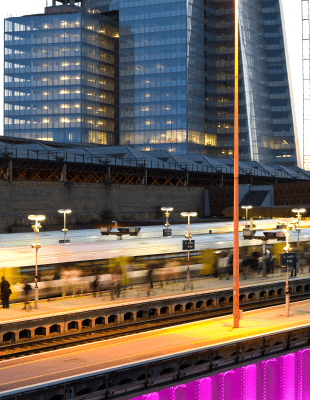High speed rail has the potential to cross city limits and generate economic uplift in a way that no other infrastructure project can. The final line of UK's High Speed 2 (HS2) between London and Birmingham is currently under construction and will eventually link the UK's two biggest cities and population centres within 45 minutes by rail. HS2 aims to create a corridor of economic and social opportunity for the regions to trade, grow and thrive - and with the line likely to open between 5-10 years from now, it is already proving to be a powerful catalyst for growth, sustainability and housing.
High speed rail does more than create jobs for construction companies, engineers and railway workers. It provides pathways to new employment opportunities and industries in regional areas. It also provides scope for the private sector to invest in large-scale projects that will transform the local community and economy.
A recent report carried out by Arcadis and published by HS2 Limited - From trains to cranes: HS2 and the West Midlands’ development boom – features a deep dive into some of the revitalised areas resulting from HS2’s ripple. For instance, Arden Cross, situated in a prime position near HS2's Birmingham Interchange Station (Birmingham International Railway Station and Birmingham Airport), is one of the UK's most significant regeneration opportunities. The 140-hectare site will be a future innovation district, with an MOU with the University of Warwick to explore a HealthTech Campus at the heart of the development. Tens of thousands of jobs and thousands of new homes, in addition to commercial, leisure and new public green spaces, will provide what Carl Potter, the Project Director at Arden Cross Limited, aptly called "the perfect microclimate for investment innovation, and growth." HS2 enabled this.
Digbeth, a Birmingham neighbourhood generally considered in decline, is also experiencing a renaissance. Digbeth Loc. Studios, conceived by Peaky Blinders creator Steven Knight, will revitalise 80,000 square feet of commercial space, converting abandoned Victorian and industrial buildings on brownfield land into an important cutting-edge film and TV studio. In turn, this will create 760 local employment opportunities, fostering the next generation of creative talent in the Midlands. HS2 focused attention on Digbeth's potential to be that next creative hub.
In fact, over the next decade, it is estimated that HS2 will be responsible for the creation of 30,835 new jobs within HS2's three impact zones, underscoring high speed rail's role as a catalyst for employment opportunities.
The Australian city of Newcastle, with its world-class university, healthcare hub, airport and ports, has many similarities to the UK's Birmingham. The potential is there, it just needs a jolt—that shot of adrenalin—for its full potential to be realised. . High speed rail could be that jolt.
Pioneering sustainable rail
High speed rail projects like HS2 drive economic growth and pave the way for a more sustainable and resilient future. By investing in cutting-edge technology and resilient infrastructure, HS2 sets a new standard for transportation systems designed to withstand the challenges of climate change. Integrating real-time sensors into the infrastructure has enhanced the system's reliability and resilience, ensuring efficient operations and timely response to potential disruptions.
The unfortunate truth is that implementing new technologies and sustainability strategies is easier on new projects than on legacy infrastructure. Thanks to our sparse population across the regions, connecting our cities will cover hundreds of thousands of kilometres of empty terrain. We will need to be one step ahead for maintenance, faults and delays – and many of these challenges will be beyond our control. Australia is a country well-known for its extremes – for fire, flood and drought. Sustainability and resilience must be a priority for any future infrastructure project, particularly of this scale and scale of investment. The potential is enormous.
As we move forward, it's imperative to dispel the mythology surrounding high speed rail and embrace its evidence-backed potential. Australia's future hinges on bold, forward-thinking infrastructure investments, and high speed rail is poised to be pivotal in shaping that future. By leveraging the lessons from HS2, we can create our own catalyst towards a more connected, sustainable, and prosperous Australia for generations to come.





